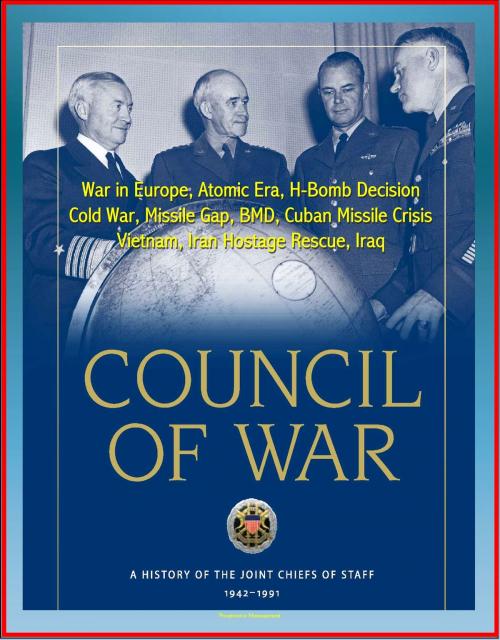Council of War: A History of the Joint Chiefs of Staff 1942-1991 - War in Europe, Atomic Era, H-Bomb Decision, Cold War, Missile Gap, BMD, Cuban Missile Crisis, Vietnam, Iran Hostage Rescue, Iraq
Nonfiction, History, Middle East, Persian Gulf War, Military, United States| Author: | Progressive Management | ISBN: | 9781301617845 |
| Publisher: | Progressive Management | Publication: | January 19, 2013 |
| Imprint: | Smashwords Edition | Language: | English |
| Author: | Progressive Management |
| ISBN: | 9781301617845 |
| Publisher: | Progressive Management |
| Publication: | January 19, 2013 |
| Imprint: | Smashwords Edition |
| Language: | English |
Council of War: A History of the Joint Chiefs of Staff, 1942—1991 follows in the tradition of volumes previously prepared by the joint History Office dealing with JCS involvement in national policy, the Korean War, and the Vietnam War. Adopting a broader view than earlier volumes, it surveys the JCS role and contributions from the early days of World War II through the end of the Cold War. Written from a combination of primary and secondary sources, it is a fresh work of scholarship, looking at the problems of this era and their military implications. The main prism is that of the joint Chiefs of Staff, but in laying out the JCS perspective, it deals also with the wider impact of key decisions and the ensuing policies.
The narrative traces the role and influence of the Joint Chiefs of Staff from their creation in 1942 through the end of the Cold War in 1991. It is, first and foremost, a history of events and their impact on national policy. It is also a history of the Joint Chiefs of Staff themselves and their evolving organization, a reflection in many ways of the problems they faced and how they elected to address them. Over the years, the Joint History Office has produced and published numerous detailed monographs on JCS participation in national security policy. There has never been, however, a single-volume narrative summary of the JCS role. This book, written from a combination of primary and secondary sources, seeks to fill that void.
Contents: Chapter 1 * THE WAR IN EUROPE * The Origins of Joint Planning * The North Africa Decision and Its Impact * The Second Front Debate and JCS Reorganization * Preparing for Overlord * Wartime Collaboration with the Soviet Union * Chapter 2 * THE ASIA-PACIFIC WAR AND THE BEGINNINGS OF POSTWAR PLANNING * Strategy and Command in the Pacific * The China-Burma-India Theater * Postwar Planning Begins * Ending the War with Japan * Dawn of the Atomic Age * Chapter 3 * PEACETIME CHALLENGES * Defense Policy in Transition * Reorganization and Reform * War Plans, Budgets, and the March Crisis of 1948 * The Defense Budget for FY 1950 * The Strategic Bombing Controversy * Chapter 4 * MILITARIZING THE COLD WAR * Pressures for Change * The H-Bomb Decision and NSC 68 * Onset of the Korean War * The Inch'on Operation * Policy in Flux * Impact of the Chinese Intervention * MacArthur's Dismissal * Europe—First Again * Chapter 5 * EISENHOWER AND THE NEW LOOK * The 1953 Reorganization * Ending the Korean War * A New Strategy for the Cold War * Testing the New Look: Indochina * Confrontation in the Taiwan Strait * The "New Approach" in Europe * NATO's Conventional Posture * Curbing the Arms Race * Chapter 6 * CHANGE AND CONTINUITY * Evolution of the Missile Program * The Gaither Report * The "Missile Gap" and BMD Controversies * Reorganization and Reform, 1958—1960 * Defense of the Middle East * Cuba, Castro, and Communism * Berlin Dangers * Chapter 7 * KENNEDY AND THE CRISIS PRESIDENCY * The Bay of Pigs * Berlin under Siege * Laos * Origins of the Cuban Missile Crisis * Showdown over Cuba * Aftermath: The Nuclear Test Ban * Chapter 8 * THE MCNAMARA ERA * Chapter 9 * VIETNAM: GOING TO WAR * Chapter 10 * VIETNAM: RETREAT AND WITHDRAWAL * Chapter 11 * DETENTE * Chapter 12 * THE SEARCH FOR STRATEGIC STABILITY Chapter 13 * THE RETURN TO CONFRONTATION SALT II * Chapter 14 * THE REAGAN BUILDUP * Chapter 15 * A NEW RAPPROCHEMENT * Chapter 16 * ENDING THE COLD WAR * Chapter 17 * STORM IN THE DESERT * Origins of the Chapter 18 * CONCLUSION * Glossary
Council of War: A History of the Joint Chiefs of Staff, 1942—1991 follows in the tradition of volumes previously prepared by the joint History Office dealing with JCS involvement in national policy, the Korean War, and the Vietnam War. Adopting a broader view than earlier volumes, it surveys the JCS role and contributions from the early days of World War II through the end of the Cold War. Written from a combination of primary and secondary sources, it is a fresh work of scholarship, looking at the problems of this era and their military implications. The main prism is that of the joint Chiefs of Staff, but in laying out the JCS perspective, it deals also with the wider impact of key decisions and the ensuing policies.
The narrative traces the role and influence of the Joint Chiefs of Staff from their creation in 1942 through the end of the Cold War in 1991. It is, first and foremost, a history of events and their impact on national policy. It is also a history of the Joint Chiefs of Staff themselves and their evolving organization, a reflection in many ways of the problems they faced and how they elected to address them. Over the years, the Joint History Office has produced and published numerous detailed monographs on JCS participation in national security policy. There has never been, however, a single-volume narrative summary of the JCS role. This book, written from a combination of primary and secondary sources, seeks to fill that void.
Contents: Chapter 1 * THE WAR IN EUROPE * The Origins of Joint Planning * The North Africa Decision and Its Impact * The Second Front Debate and JCS Reorganization * Preparing for Overlord * Wartime Collaboration with the Soviet Union * Chapter 2 * THE ASIA-PACIFIC WAR AND THE BEGINNINGS OF POSTWAR PLANNING * Strategy and Command in the Pacific * The China-Burma-India Theater * Postwar Planning Begins * Ending the War with Japan * Dawn of the Atomic Age * Chapter 3 * PEACETIME CHALLENGES * Defense Policy in Transition * Reorganization and Reform * War Plans, Budgets, and the March Crisis of 1948 * The Defense Budget for FY 1950 * The Strategic Bombing Controversy * Chapter 4 * MILITARIZING THE COLD WAR * Pressures for Change * The H-Bomb Decision and NSC 68 * Onset of the Korean War * The Inch'on Operation * Policy in Flux * Impact of the Chinese Intervention * MacArthur's Dismissal * Europe—First Again * Chapter 5 * EISENHOWER AND THE NEW LOOK * The 1953 Reorganization * Ending the Korean War * A New Strategy for the Cold War * Testing the New Look: Indochina * Confrontation in the Taiwan Strait * The "New Approach" in Europe * NATO's Conventional Posture * Curbing the Arms Race * Chapter 6 * CHANGE AND CONTINUITY * Evolution of the Missile Program * The Gaither Report * The "Missile Gap" and BMD Controversies * Reorganization and Reform, 1958—1960 * Defense of the Middle East * Cuba, Castro, and Communism * Berlin Dangers * Chapter 7 * KENNEDY AND THE CRISIS PRESIDENCY * The Bay of Pigs * Berlin under Siege * Laos * Origins of the Cuban Missile Crisis * Showdown over Cuba * Aftermath: The Nuclear Test Ban * Chapter 8 * THE MCNAMARA ERA * Chapter 9 * VIETNAM: GOING TO WAR * Chapter 10 * VIETNAM: RETREAT AND WITHDRAWAL * Chapter 11 * DETENTE * Chapter 12 * THE SEARCH FOR STRATEGIC STABILITY Chapter 13 * THE RETURN TO CONFRONTATION SALT II * Chapter 14 * THE REAGAN BUILDUP * Chapter 15 * A NEW RAPPROCHEMENT * Chapter 16 * ENDING THE COLD WAR * Chapter 17 * STORM IN THE DESERT * Origins of the Chapter 18 * CONCLUSION * Glossary















